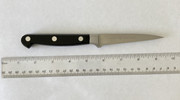- Joined
- Oct 2, 1998
- Messages
- 46,545
I knew that...but it deserved a more serious reply because it's something that folks often question.I was half kidding.Do you go through all four sharpening steps on the Sharpmaker, or just a a few light passes own the flat part lof the white rods?
I only use the flats of the brown rods. I use the corners for my wife's serrated paring knife, or a bread knife (almost) exclusively...with rare exceptions. I haven't used the fine or ultra-fine rods in some time. I don't think I've ever even used my diamond rods.
The function of the flats of the brown rods (in my usage):
1. Removal of lingering burr.
2. Possible addition of a micro-bevel. (I was going to say small micro-bevel, but a large micro-bevel wouldn't be micro, would it?)
3. Touching up an already relatively sharp knife which gets a small ding or roll, generally from kitchen usage where my missus is prone to create them.
Use light strokes. This cannot be emphasized enough...especially if used for the purposes I outlined. Sometimes just the weight of the knife alone, with you simply guiding it, is (more than) enough.




